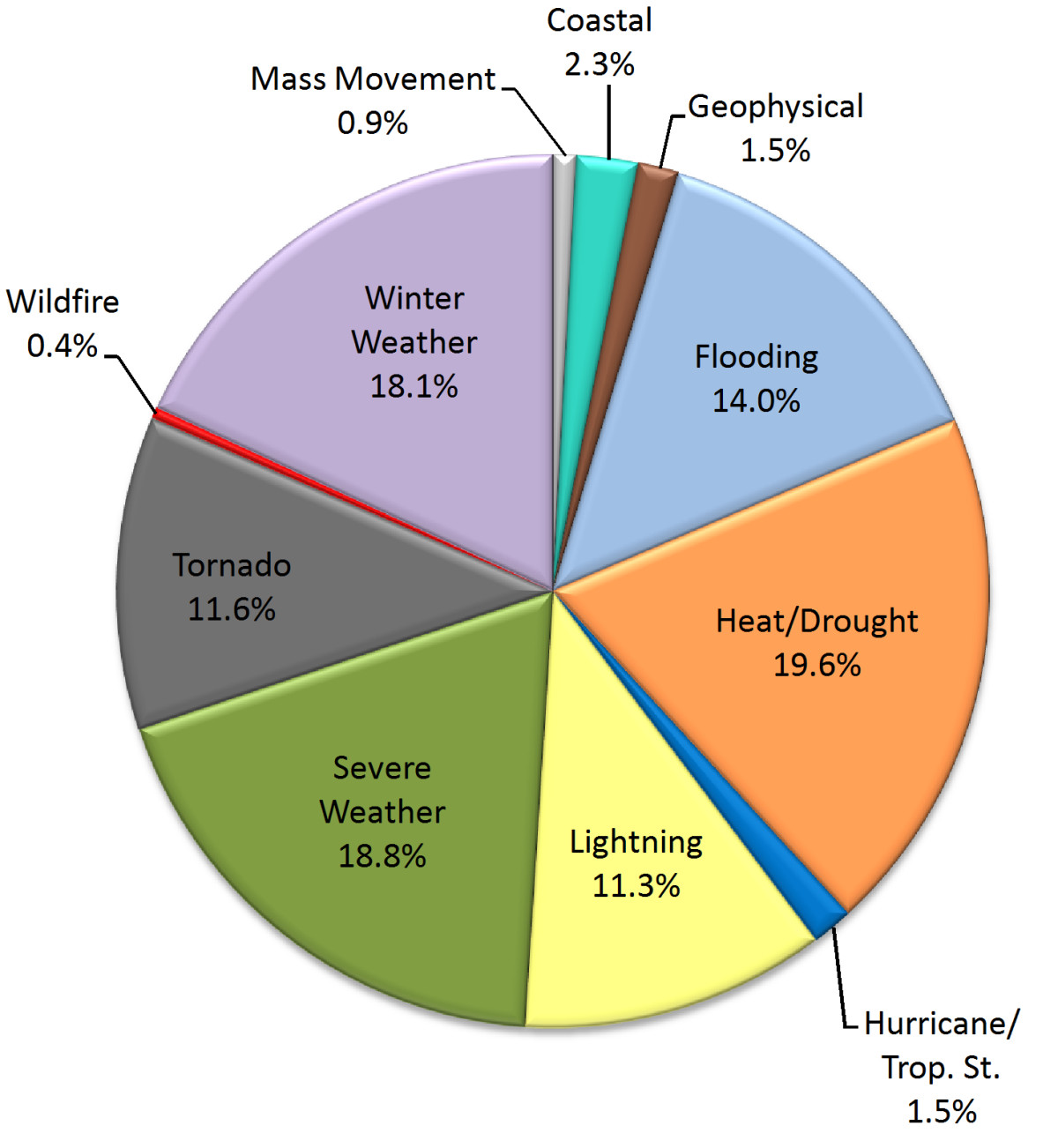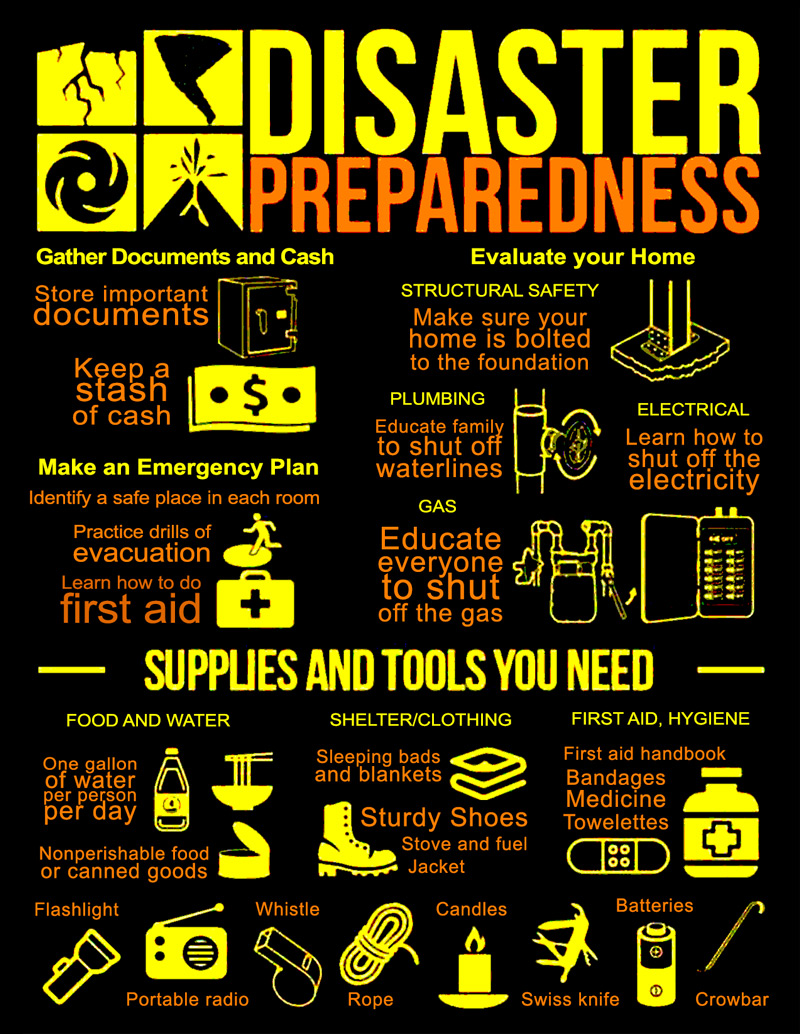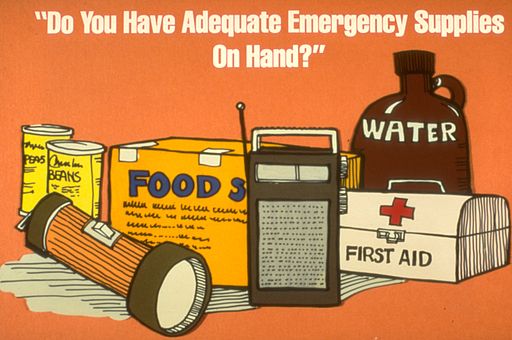From Clatsop County, OR Emergency Management
Family Disaster Plan
Prepare your household by creating a family disaster plan. Your family plan should address the following:
Escape Routes
Draw a floor plan of your home. Use a blank sheet of paper for each floor. Mark two escape routes from each room. Make sure children understand the drawings. Post a copy of the drawings at eye level in each child’s room.
Where to Meet
Establish a place to meet in the event of an emergency, such as a fire. Record the locations below:
-
Near the home - for example, the next door neighbor’s
-
Telephone pole
-
Outside the immediate area - for example, the neighborhood grocery store parking lot
Family Communications
Your family may not be together when disaster strikes, so plan how you will contact one another. Think about how you will communicate in different situations.
Complete a contact card for each family member. Have family members keep these cards handy in a wallet, purse, backpack, etc. You may want to send one to school with each child to keep on file. Pick a friend or relative who lives out-of-state for household members to notify they are safe.
The American Red Cross offers a Safe and Well website to provide families with a tool to exchange welfare information with loved ones and friends in the immediate aftermath of a disaster. The site allows a disaster victim to select and post standard messages for friends and family that indicate the victim is safe and well and will make contact when they are able. Those worried about the safety of a victim can access the site, enter either the name and telephone number or name and complete address of the person in question, and view their "safe and well" messages.
Emergency Kit
In a major emergency, you may not have access to basic necessities for an extended period. Assemble a 3-day minimum supply of the following:
-
First-aid supplies and personal prescriptions
-
Non-perishable food and utensils
-
Water (one gallon per person per day)

-
Water carrying bag or container
-
Extra blankets, ponchos and clothes
-
Plastic bags for garbage and waste
-
Rubber, latex, and heavy-duty gloves
-
Pocket knife, flat 12" pry bar, and duct tape
-
Tube tent
-
Flashlights (extra batteries)
-
Battery-operated AM radio (extra batteries)
-
Whistles
-
Dental and personal hygiene items
-
Dust masks
-
Matches
Utility Shut-off and Safety
In the event of a disaster, you may be instructed to shut off the utility service at your home.
Below is some general guidance for shutting off utility service. Modify the information provided to reflect your shut-off requirements as directed by your utility company(ies).
Natural Gas
Natural gas leaks and explosions are responsible for a significant number of fires following disasters. It is vital that all household members know how to shut off natural gas.
Because there are different gas shut-off procedures for different gas meter configurations, it is important to contact your local gas company for guidance on preparation and response regarding gas appliances and gas service to your home.
When you learn the proper shut-off procedure for your meter, share the information with everyone in your household. Be sure not to actually turn off the gas when practicing the proper gas shut-off procedure.
If you smell gas or hear a blowing or hissing noise, open a window and get everyone out quickly. Turn off the gas, using the outside main valve if you can, and call the gas company from a neighbor’s home.
CAUTION - If you turn off the gas for any reason, a qualified professional must turn it back on. NEVER attempt to turn the gas back on yourself.
Water
Water quickly becomes a precious resource following many disasters. It is vital that all household members learn how to shut off the water at the main house valve.
Cracked lines may pollute the water supply to your house. It is wise to shut off your water until you hear from authorities that it is safe for drinking.
The effects of gravity may drain the water in your hot water heater and toilet tanks unless you trap it in your house by shutting off the main house valve (not the street valve in the cement box at the curb – this valve is extremely difficult to turn and requires a special tool).
Locate the shut-off valve for the water line that enters your house. Make sure this valve can be completely shut off. Your valve may be rusted open, or it may only partially close. Replace it if necessary. Label this valve with a tag for easy identification, and make sure all household members know where it is located.
Electricity
Electrical sparks have the potential of igniting natural gas if it is leaking. It is wise to teach all responsible household members where and how to shut off the electricity.
Locate your electricity circuit box. Teach all responsible household members how to shut off the electricity to the entire house. FOR YOUR SAFETY: Always shut off all the individual circuits before shutting off the main circuit breaker.
Insurance and Vital Records
Obtain property, health, and life insurance if you do not have them. Review existing policies for the amount and extent of coverage to ensure that what you have in place is what is required for you and your family for all possible hazards.
Flood Insurance
If you live in a flood-prone area, consider purchasing flood insurance to reduce your risk of flood loss. Buying flood insurance to cover the value of a building and its contents will not only provide greater peace of mind, but will speed the recovery if a flood occurs. You can call learn more about the National Flood Insurance Program here.
Inventory Home Possessions
Make a record of your personal property, for insurance purposes. Take photos or a video of the interior and exterior of your home. Include personal belongings in your inventory.
You may also want to download the free Household and Personal Property Inventory Book to help you record your possessions.
Important Documents
Store important documents such as insurance policies, deeds, property records, and other important papers in a safe place, such as a safety deposit box away from your home. Make copies of important documents for your disaster supplies kit.
Money
Consider saving money in an emergency savings account that could be used in any crisis. It is advisable to keep a small amount of cash or traveler’s checks at home in a safe place where you can quickly access them in case of evacuation.
Special Needs
If you or someone close to you has a disability or a special need, you may have to take additional steps to protect yourself and your family in an emergency.
-
Hearing impaired – May need to make special arrangements to receive warnings.
-
Mobility impaired – May need special assistance to get to a shelter.
-
Single working parent – May need help to plan for disasters and emergencies.
-
Non-English speaking persons – May need assistance planning for and responding to emergencies. Community and cultural groups may be able to help keep people informed.
-
People without vehicles – May need to make arrangements for transportation.
-
People with special dietary needs – Should take special precautions to have an adequate emergency food supply.
Find out about special assistance that may be available in your community. Create a network of neighbors, relatives, friends, and coworkers to aid you in an emergency. Discuss your needs and make sure everyone knows how to operate necessary equipment. Discuss your needs with your employer.
If you are mobility impaired and live or work in a multi-level building, have an escape chair. If you live in an apartment building, ask the management to mark accessible exits clearly and to make arrangements to help you leave the building. Keep specialized items ready, including extra wheelchair batteries, oxygen, catheters, medication, food for service animals, and any other items you might need. Be sure to make provisions for medications that require refrigeration.
Keep a list of the type and model numbers of the medical devices you require.
Caring for Animals
Animals also are affected by disasters. Use the guidelines below to prepare a plan for caring for pets and large animals.
Plan for pet disaster needs by:
-
Identifying shelter
-
Gathering pet supplies
-
Ensuring your pet has proper ID and up-to-date veterinarian records
-
Providing a pet carrier and leash
Contact Animal Control and Shelter to get advice and information.
Keep veterinary records to prove vaccinations are current. Find out which local hotels and motels allow pets and where pet boarding facilities are located. Be sure to research some outside your local area in case local facilities close.
Know that, with the exception of service animals, pets are not typically permitted in emergency shelters as they may affect the health and safety of other occupants.
Guidelines for Large Animals
If you have large animals such as horses, cattle, sheep, goats or pigs on your property, be sure to prepare before a disaster.
-
Ensure all animals have some form of identification.
-
Evacuate animals whenever possible. Map out primary and secondary routes in advance.
-
Make available vehicles and trailers needed for transporting and supporting each type of animal. Also make available experienced handlers and drivers. Note: It is best to allow animals a chance to become accustomed to vehicular travel so they are less frightened and easier to move.
-
Ensure destinations have food, water, veterinary care, and handling equipment.
-
If evacuation is not possible, animal owners must decide whether to move large animals to shelter or turn them outside.
Safety Skills
It is important that family members know how to administer First Aid and CPR and how to use a fire extinguisher.
Learn First Aid and CPR: Take a First Aid and CPR class. The local American Red Cross chapter can provide information about
this type of training. Official certification by the American Red Cross provides, under the “good Samaritan” law, protection for those giving first aid.
Learn How to Use a Fire Extinguisher: Be sure everyone knows how to use your fire extinguisher(s) and where it is kept. You should have, at a minimum, an ABC type.
Volunteer for your local CERT team
Map showing the relative risk of death in various regions of the U.S., with blue being safest and red being most hazardous. Note that it does not correspond to the quake zones of California, but to the South and the Rockies, where the death from storms, hurricanes, and heat waves are more likely. From Borden and Cutter (2008)
Flat tires, car accidents, dead batteries, and extreme weather conditions are all potential causes of an automotive emergency. During an emergency, drivers are typically unable to operate their vehicles, which can leave them stuck on the side of the road. These situations are often unpredictable and can happen to even the most careful drivers. During long road trips, drivers and their passengers may find themselves stranded for hours before help arrives. Smart drivers prepare for unexpected situations by creating and keeping an emergency roadside kit in their vehicles. A car kit should be packed with items that are immediately useful in an emergency situation, whether it is to keep a person safe or to help make minor fixes that are necessary to get the car temporarily back on the road. Roadside kits can be tailored to suit specific seasonal needs, as some items are not necessary year-round. Regardless of the season, it’s important for drivers to pack their kits with basic items that could be needed in an emergency situation.

3 Easy Steps To Prepare For An Emergency | American Red Cross
The Lifeboat Show*: Emergency Preparedness
Learn simple steps that could save your life, your family, and your neighbors. Find out what community resources are available -- and unavailable -- and where to volunteer & get involved. Join us with guest speakers Vanessa Clarkson (American Red Cross), Patrick Corcoran (NOAA Coastal Hazards), Don Hillgartner of (Amateur Radio Emergency Services), Mike Jackson (Fire & Rescue), Tom Manning of (County Emergency Services Chief), and Deb Treusdell (Tsunami Prep. Specialist). Wherever you live, you will get important personal and family preparedness information from these two inspiring shows.
 Part 1
Part 1  Part 2
Part 2
*The Lifeboat Show was a monthly radio program produced by Caren Black and Christopher Paddon on Coast Community Radio in Astoria, Oregon.
More Resources
Car Roadside Emergency Kit Guide
Guide to Saving Money on Disaster Preparation



